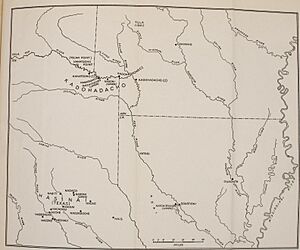Hasinai facts for kids

Angelina River, west of Nacogdoches, Texas, ancestral Hasinai homeland
|
|
| Total population | |
|---|---|
| under 5,757 | |
| Regions with significant populations | |
| formerly currently |
|
| Languages | |
| Hasinai, English | |
| Religion | |
| Native American Church, Christianity | |
| Related ethnic groups | |
| Hainai, Nabedache, Nabiti, Nacogdoche, Nacono, Nadaco, Nasoni (Lower), Nechaui, Neche, and other Caddo people |
The Hasinai Confederacy was a big group of Native American tribes. They spoke a language related to Caddo. These tribes lived in eastern Texas between the Sabine and Trinity rivers. Today, their family members are part of the Caddo Nation of Oklahoma.
Contents
What Does "Hasinai" Mean?
The name Hasinai has many different spellings, like Hasini or Asenai. It means "our own people" in the Caddoan language. The Spanish explorers called the Hasinai people Tejas or Texas. This word came from a greeting that meant "friend." This is how the state of Texas got its name!
How the Hasinai Were Governed
When Spanish and French explorers met the Hasinai in the 1680s, they saw a well-organized group. A religious leader called the Grand Xinesi was in charge. He lived in a special, quiet house. He would meet with a group of older, wise people to make decisions.
The Hasinai government had several smaller parts, like different towns or areas. Each of these areas had its own leader, called a Caddi. There were also other important people called Canahas and Chayas. They helped the Caddi manage everything.
Hasinai History
During the 1600s, the Hasinai traded with another group called the Jumano. They traded at a western Hasinai city named Nabedache. Some people think the residents of Nabedache were a separate group of people.
How Many Hasinai People Lived?
Around the year 1520, it's thought that about 250,000 people lived in the groups that would become the Hasinai, the Kadohadacho, and the Natchitoches. But over the next 250 years, their numbers dropped a lot. This happened because of diseases like smallpox that Spanish and French colonists brought. Native Americans had never been exposed to these diseases before. This meant they got very sick and many people died.
In 1690, there were about 10,000 Hasinai people. But by 1720, because of these diseases, the Hasinai population had fallen to only 2,000 people.
Related Native American Groups


